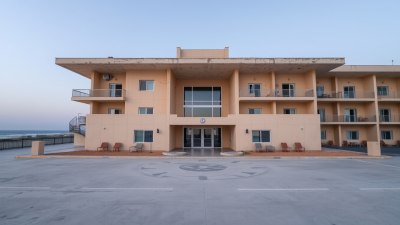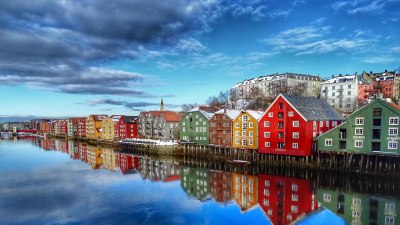The Color of Quiet in the Empty Hotels of Varosha
Exploring the haunting beauty and silence of Varosha's abandoned hotels.

The Color of Quiet in the Empty Hotels of Varosha evokes a sense of mystery and nostalgia, where time appears to stand still. Situated in the city of Famagusta, Varosha was once a thriving resort destination in Cyprus, attracting tourists from all over the world. Its sandy beaches, luxurious hotels, and vibrant nightlife made it a beacon of leisure on the Mediterranean landscape. However, following the Turkish invasion of 1974, Varosha was left abandoned overnight, turning it into a ghost town.
The abrupt departure of its residents and visitors stripped the area of its vibrant life, leaving behind skeletal structures covered in layers of dust and silence. The Color of Quiet refers not only to the physical emptiness of the dozens of hotels lining its shores but also to the melancholic soundscape that envelops them. Walking through the crumbling halls and abandoned rooms, one can almost hear the whispers of laughter and the echoes of waves crashing against the shore, stories permanently halted.
A Glimpse into the Past
The contrast between the past vibrancy of Varosha and its current desolation is striking. In the 1960s and early 70s, Varosha was the ultimate holiday destination, where boomers flocked to experience the sun, sea, and party atmosphere. Hotel management and hospitality flourished, with millions invested in developments designed to cater to international tourists seeking sun-soaked vacations. The color of the resort—azure blue skies, golden sand, and Mediterranean greens—was what attracted visitors eager for respite from their daily lives.
Hotels such as the once-magnificent Golden Coast Hotel and the luxurious Salamis Bay Conti Resort became icons of opulence, their grand facades characterized by modernist architecture that promised indulgence and leisure. However, as one roams through these deserted properties today, the delightful pastel colors of yesteryear have faded into muted grays and browns, offering a stark reminder of their past glory and present reality.
The Silent Sentinels
Time has rendered these hotels as silent sentinels of memories, remnants of happier times anchored in a sea of quietude. The windows of the hotels, once adorned with the vibrance of life and laughter, now stare blankly at the sunlit oceans, concealing stories within their glass. The empty pools, previously filled with the splashes and shouts of children, now reflect a tranquil blue sky, serving only as mirrors to a world that has moved on.
Each hotel has its own character, its ghostly aura palpable; the flickering memories of sunset barbecues, poolside soirées, and beach games float amid the peeling paint and overgrown gardens. The air carries a weight of tranquility mixed with sorrow. As you walk through the vast halls of these establishments, the silence is punctuated only by the chill of the Cyprus breeze, weaving its way through broken doors and cracked walls.
The Intriguing Architecture
The architecture of Varosha's hotels stands as a testament to a bygone era of resort design. The clean lines and bold designs of the 20th century seem out of place in the current desolation. The fusion of modernist styles with local influences creates a unique visual narrative that enhances the haunting beauty of the remnants. Visitors who come to explore these abandoned hotels find themselves captivated by the aesthetic—arts and crafts mingle with mid-century modernism in unexpected ways.
Color plays an essential role in this visual story. While the vibrant hues have faded over the decades, hints of the original tones can still be seen in the large tiled living areas and in the colorful mosaics that adorn the pools and terraces. This reclamation of color amidst the decay serves as a reminder that beauty can linger even in silence and abandonment. As nature takes hold of these spaces, the intricate play of light and shadow adds an ethereal dimension to the experience.
The Resilient Nature
As the hotels and buildings remain in their state of stillness, nature works tirelessly to reclaim the land. Plants and trees grow through the cracks in concrete, bursting forth with life in defiance of decay. The once manicured garden pathways are now enveloped with wild grasses and flowering vines, creating a juxtaposition of nature's resilience against human efforts. The Color of Quiet in this context includes the vibrant greens of the overgrowth, the rustle of leaves, and the sounds of birds returning to the area.
While nature's reclamation is a poignant reminder of the passage of time, it also introduces a new spectrum of color—Emerald greens, deep browns, and earthy tones fill the void left by human absence, creating an organic tapestry that contrasts with the grounded structures. The coexistence of the remnants of human life and the burgeoning wilderness creates a unique art installation that continues to evolve.
Memories of the People
The Color of Quiet also touches upon the memories of the people who once inhabited this space. Personal narratives blend with collective history as the residents recount stories of their lives in Varosha. Many had grown up in homes that became hotels, had experienced love stories amid the vibrant streets, and fully embraced the lifestyle of their once-bustling community.
Families were connected to their neighbors, sharing laughs at picnics on the beach and late-night celebrations in their preferred hotels. The impacts of displacement resonate in the hearts of these individuals—a poignant reminder that the Color of Quiet comes not only from the absence of people but from the irreplaceable memories of their everyday lives intertwined with this picturesque landscape.
The Contemporary Resonance
Today, Varosha stands as a symbol of cultural heritage, historical depth, and socio-political consequences. The presence of abandoned hotels on this beautiful shoreline carries significant weight in the context of Cyprus's divided history. As one walks through the empty spaces, there's a feeling of pending renaissance—the possibility of future restoration and reconnection hangs in the air.
Recent discussions surrounding the reopening of Varosha for tourism have sparked interest and debate. Many view this as a hopeful sign of reconciliation, where history and heritage might be restored. The nuances of reopening such a place, however, remain complicated, influenced by past conflicts and the ongoing political strife on the island. The future of these empty hotels tests the boundaries between nostalgia, identity, and the modern world, resulting in a conversation that bridges generations.
Conclusion: The Color of Hope
As we reflect on the Color of Quiet in the Empty Hotels of Varosha, it becomes clear that the story encapsulates a spectrum of human experience—the intertwining of joy, sorrow, hope, and renewal. The vibrant talks of yesterday's glimmering future contrast sharply with the muted serenity of today’s realities. Through exploration, preservation, and care, we can transform this silence into dialogues that honor the past while paving the way for the future.
In showcasing Varosha, its deserted hotels, its stories, and the echoes of the laughter that once filled its air, we encounter a palette not solely defined by decay but enriched through the lens of resilience, culture, and the potential for rebirth. This emblematic landscape serves as a reflection of the indomitable spirit of humanity—an enduring testament to the colors that exist beyond the silence. The Color of Quiet is, ultimately, a nuanced story, inviting exploration, appreciation, and above all, hope for what lies ahead.











